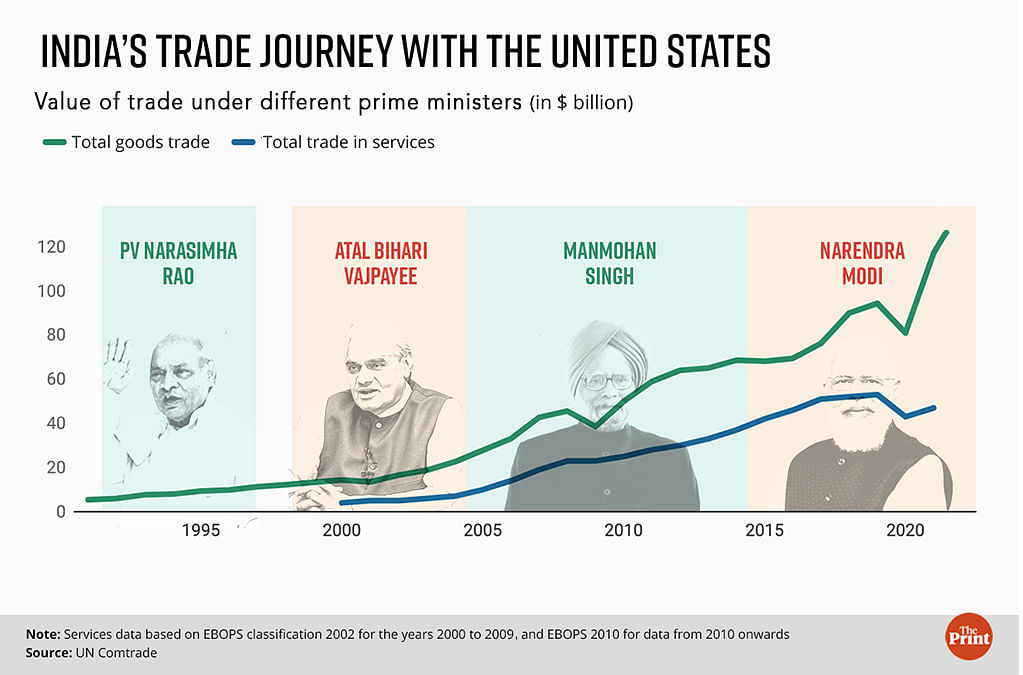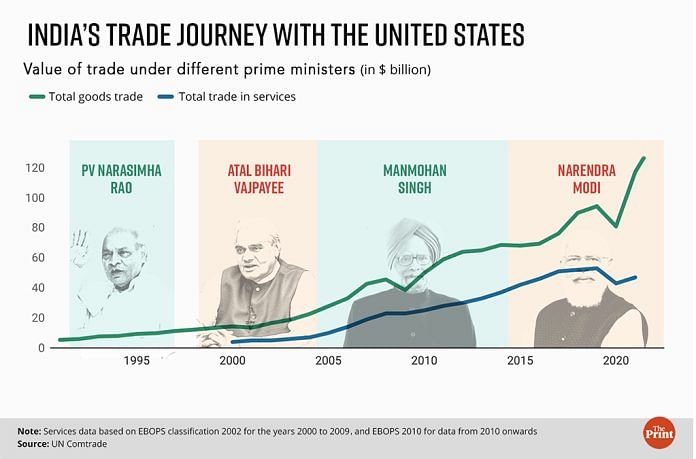New Delhi: In 1971, former US President Richard Nixon had only unflattering words for then Indian Prime Minister Indira Gandhi. Ties between the two nations at the time were at their nadir.
Fast forward 50 years, India and the US are celebrating a bilateral partnership that is set to “define” the 21st Century.
Much has transformed between the two countries in the past five decades, with ties evolving across various forums, both bilateral and multilateral, and a myriad set of agreements signed in rapid succession, the key ones being the 2005 US-India Open Skies aviation pact and the 2008 nuclear deal.
“The US found India to be a reliable partner in South Asia and a responsible nuclear power in the region, which led to closer ties between the two countries,” Arvind Kumar, a professor of US studies in Jawaharlal Nehru University, told ThePrint.
The US has also become India’s largest trading partner in four of the last five fiscal years. According to provisional data from the ministry of commerce, US-India trade in goods touched $128 billion in 2022-23.
The two nations are also part of a supply chain agreement, and are collaborating in the defence and space sectors under the US-India Initiative on Critical and Emerging Technologies (iCET).
Last week, PM Narendra Modi concluded an official state visit to the US, being only the second Indian PM to be invited by the nation for such a visit.
In his opening remarks during his one-on-one meeting with US President Joe Biden in the White House, Modi stated that “India and the US are walking shoulder-to-shoulder from the depths of the ocean to the heights of the sky, from ancient culture to artificial intelligence”.
It has been reported by Reuters that, following Modi’s visit, the US is set to ease H-1B visa norms for skilled Indian workers, who are the most active users of its visa programme and made up 73 per cent of the H-1B visas allotted in fiscal 2022.
During his visit, Modi announced that India will be signing the Artemis Accords, a National Aeronautics and Space Administration (NASA)-led initiative for the peaceful, sustainable and transparent cooperation in space.
ThePrint takes a look at the growth in trade and ties between India and the US under various prime ministers, and its implications.
Also Read: US is rolling out the red carpet for Modi. But White House knows Indian PM is his own man
Focus on US under Indian PMs
In 1991, the year that India opened its economy to the rest of the world and introduced a free market system, trade in goods between India and the US stood at $5.42 billion, according to data reported by the US to the UN Comtrade, a global trade database maintained by the United Nations Department of Economic and Social Affairs.
Under P.V. Narasimha Rao, who took over as prime minister in 1991, trade in goods with the US grew at a compound annual rate of about 12.67 per cent, reaching $9.86 billion in 1996, the year he demitted office.
When Atal Bihari Vajpayee became PM in 1998, trade between the two countries stood at $12.2 billion. Throughout his tenure till 2004, trade in goods grew at an annual average rate of 10.8 per cent.
Under Manmohan Singh, who was PM from 2004 to 2014, trade in goods between India and the US grew rapidly from $22.56 billion in 2004 to $68.59 billion in 2014. The trade numbers more than tripled, according to data from the UN Comtrade.
From 2014 to 2022, under PM Modi, trade in goods between India and the US grew at an average rate of about 9.2 per cent, to reach its current figure of $128 billion in 2022-23.

Explaining the trends in US-India trade, Biswajit Nag, a professor of economics at Indian Institute of Foreign Trade, told ThePrint that after liberalisation of the Indian economy, trade saw a sharp increase from 2001 till the US subprime mortgage crisis of 2008.
“After the subprime mortgage crisis and the effects of recession in the US, trade (between India and the US) rose sharply again between 2010 and 2014, and for a third time from 2017 till now,” he said.
Nag described the US as one of the most important trading partners for India, and said that US president Bill Clinton’s visit to Agra in March 2000 was a point from which the India-US partnership took a different turn.
“The joint statement issued by Clinton and PM Vajpayee in March 2000 set up the US-India Commercial Dialogue to help facilitate trade and investment,” he added.
Nag also highlighted how certain agreements changed the face of India-US relations. The 2005 India-US aviation agreement removed limitations on routes, capacity, pricing and frequency in the civil aviation sector, while the 2008 nuclear pact saw India agreeing to commit all its civil nuclear facilities to International Atomic Energy Agency safeguards. In return, the US promised to seek exemption from the Nuclear Suppliers Group to allow India to commence with civilian nuclear trade.
“In 2018, India was the third Asian country to gain the Strategic Trade Authorisation-1 status from the US, allowing for trade in high technology products between the two countries, specifically in space and defence,” he pointed out.
The iCET, deeper cooperation in the defence sector as well as focus on semiconductors and supply chains under the Indo-Pacific Economic Framework for Prosperity are a few other areas that highlight the trend of the India-US partnership, explained Nag.
Professor Kumar explained to ThePrint that the global challenges currently being faced by the two nations are similar and this has led to closer cooperation.
He added that India is well placed to be a partner in solving the most pressing global challenges confronting the US.
“The US had not considered terrorism till the September 11, 2001, attack on the World Trade Center in its relationship with Pakistan, after which India emerged as a responsible partner in the region,” said Kumar.
He pointed out that “an example of India’s responsible actions is how it achieved its Paris Agreement goals for switching to renewable energy by December 2022, even though the target was 2030”.
During a joint press conference held by Biden and Modi last Thursday, the PM said: “You perhaps know that of all the G20 countries, India is the only country that has fulfilled all the promises it made in Paris.”
Implications of strong partnership with US
In the 1970s, the US viewed India unfavourably, especially during Nixon’s time, 1969 to 1974.
Conversations recorded between Nixon and then US national security adviser Henry Kissinger, according to declassified documents, highlighted that the then US administration believed Indians were the “most aggressive people around”. In the wake of the 1971 India-Pakistan conflict, Nixon reportedly said “who’s going to care about losing the Indians forever?”
On 8 December, 1971, the US administration took the decision to send an aircraft carrier to the Bay of Bengal in a move designed to counter India’s position in the war. The Soviet Union deployed its naval assets in the Bay of Bengal as well to support India’s position, according to a report in The Hindu.
Given the traditional support the Soviet Union and following its dissolution Russia has provided India, does the new US-India partnership change this?
Sanjay Kumar Pandey, professor in the Centre for Russian and Central Asian Studies at Jawaharlal Nehru University, told ThePrint that one can’t look at foreign relations with a binary view of “either one or the other”.
“Countries are engaging in multi-vector diplomacy today, engaging with various partners on different issues. India is acting in accordance with the prevailing international statecraft,” he said.
Pandey explained that the 1991 economic reforms in India gave a fillip to US-India relations and this has been the norm over the last three decades, with the Russians being fully aware of the same.
“Russia themselves have been playing a balancing act between their relationship with the Chinese and India. This is just the current global scenario,” he added.
Pandey further said that it would be beneficial to the US — if the larger goal is to contain China — to ensure that India and Russia remain close allies, and the Russians do not go all in with the Chinese.
“There may be some fallout between India and Russia going forward, but that is to be seen,” he added.
(Edited by Nida Fatima Siddiqui)
Also Read: Trump not first arrogant US President. Richard Nixon talked nuclear strike on India in ’71



